Is it a bird? Is it a plane? No, it's a flying mobula ray soaring high off the Mexican shore
Lurking off Mexico's eastern shore in the Sea of Cortez, these flap-jack-like creatures burst out of the water with graceful precision.Soaring as high as two metres above the plankton-rich green water, mobula rays are a sight to behold.
Here in the Sea of Cortez four species of mobulas (tarapacana, thurstoni, munkiana, and japanica) occupy the waters along with the giant manta ray.
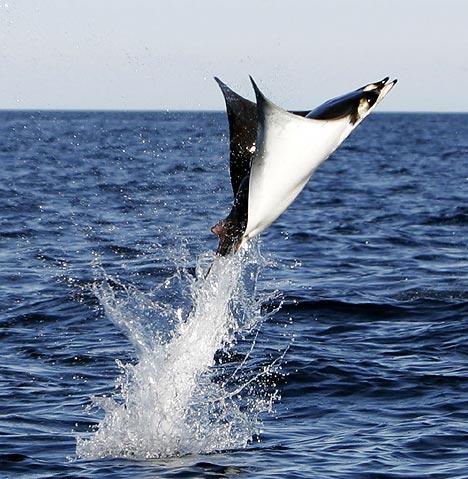
The mobula ray bursts through the water
Both mantas and mobulas are members of the Family Mobulidae, a group about which, very little is known.
Mobulas can grow up to ten feet though they are considerably smaller than their Manta Ray cousin.
Mantas, the most well known of, which is the Pacific Manta Ray, can exceed disc-like shapes of up to twenty-three feet.
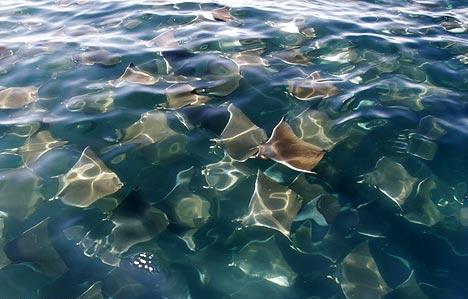
The rays flocks beneath the ocean's surface
For some time now, the comings and goings of the mobula have remained something of a mystery.
Scientists do not know why large schools spend a few days in one area, or why the disc like creatures breach the water in spectacular fashion.
Is it to dislodge the parasite-cleaning remoras that attach to their backside? Is it some way of keeping fit, of practising the underwater gathering of food? Could it be a form of play?
What if jumping was a form of co-operative hunting, a way of tricking vibration-wary mysids into migrating downwards and into the open mouths of other mobulas below?
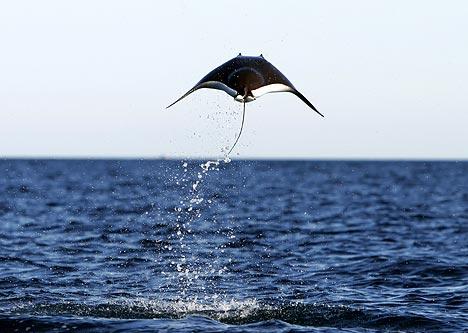
Airborne ... a mobula ray soars above the water
Keller Laros, a dive master based out of Hawaii has logged long hours underwater observing Pacific Manta Rays, the largest of munkiana's mobulid cousins.
The smaller manta ray's out-of-water acrobatics is not unlike its feeding behaviour below the surface.
Underwater, mantas have been observed doing loop after loop in the same place, concentrating their prey into a tight area.
As they circle, they direct the green soup into their mouths with the cephalic lobes found on each side of their head.
Karey Kumli, research associate at the Pacific Manta Research Group located at Santa Rosa Junior College, thinks the breaching behaviour isn't done deliberately.
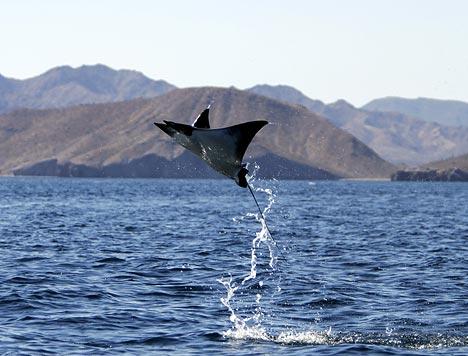
Mobula rays can grow up to 10 feet long
She said: "We wonder why they go through that plane between water and air, and I ask why would they avoid it. They'd have to be pretty careful to avoid being airborne.
"Remember, when they are in the air, there's so little resistance compared to that offered by water that a slight bend of a fin would send them tumbling."
In short, mobulas spin out in the absence of the resistance provided by water.
However, like most beautiful species of the sea they face the many dangers posed by man.
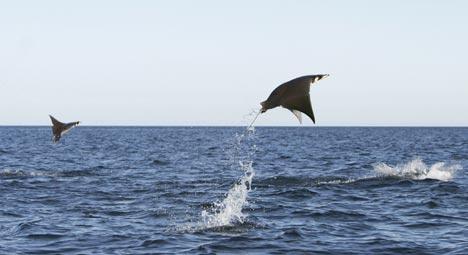
The rays can reach heights of up to two metres
SeaWatch, an environmental advocacy organisation, focus their efforts on the Sea of Cortez.
According to SeaWatch, sports fishermen in Parque Nacional Bahia de Loreto, say that their business is off 40 per cent to 50 per cent from last year, and the consensus among commercial fisherman is that there are no fish left to catch.
Longlines, trawls, spear-guns, nylon nets, and large-scale commercial operations have replaced the individual fishermen using a hand line. And it is by no means unique to the Sea of Cortez.
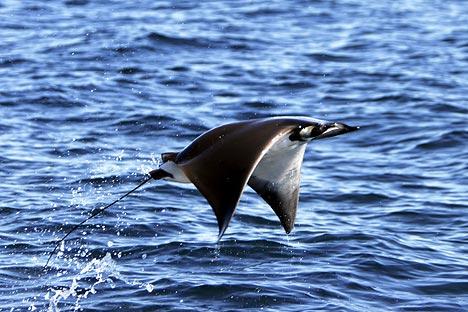
Are they playing? Or practising gathering food?
Worldwide, by-catch accounts for 20 million tons a year of unwanted fish. About one-fourth of the world's catch is thrown back.
The ratio is even higher among the take from shrimp trawlers.
Today, due in part to the work of Sea Watch, the Mexican government now imposes a $10,000 fine for those convicted of intentionally killing a Pacific Manta Ray.

The mobula ray leaps out of the water
Subscribe to:
Post Comments
(
Atom
)



No comments :
Post a Comment